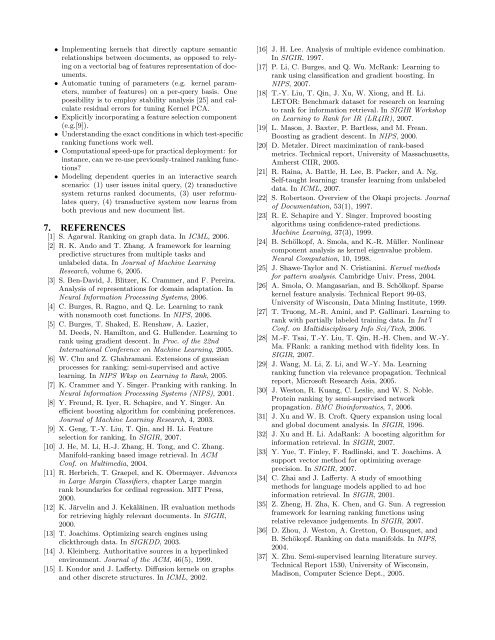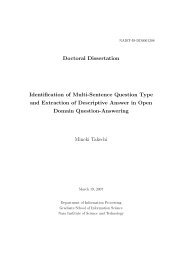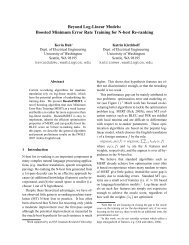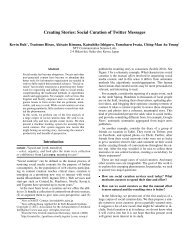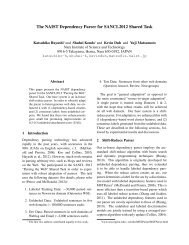Learning to Rank with Partially-Labeled Data - University of ...
Learning to Rank with Partially-Labeled Data - University of ...
Learning to Rank with Partially-Labeled Data - University of ...
Create successful ePaper yourself
Turn your PDF publications into a flip-book with our unique Google optimized e-Paper software.
• Implementing kernels that directly capture semantic<br />
relationships between documents, as opposed <strong>to</strong> relying<br />
on a vec<strong>to</strong>rial bag <strong>of</strong> features representation <strong>of</strong> documents.<br />
• Au<strong>to</strong>matic tuning <strong>of</strong> parameters (e.g. kernel parameters,<br />
number <strong>of</strong> features) on a per-query basis. One<br />
possibility is <strong>to</strong> employ stability analysis [25] and calculate<br />
residual errors for tuning Kernel PCA.<br />
• Explicitly incorporating a feature selection component<br />
(e.g.[9]).<br />
• Understanding the exact conditions in which test-specific<br />
ranking functions work well.<br />
• Computational speed-ups for practical deployment: for<br />
instance, can we re-use previously-trained ranking functions?<br />
• Modeling dependent queries in an interactive search<br />
scenario: (1) user issues inital query, (2) transductive<br />
system returns ranked documents, (3) user reformulates<br />
query, (4) transductive system now learns from<br />
both previous and new document list.<br />
7. REFERENCES<br />
[1] S. Agarwal. <strong>Rank</strong>ing on graph data. In ICML, 2006.<br />
[2] R. K. Ando and T. Zhang. A framework for learning<br />
predictive structures from multiple tasks and<br />
unlabeled data. In Journal <strong>of</strong> Machine <strong>Learning</strong><br />
Research, volume 6, 2005.<br />
[3] S. Ben-David, J. Blitzer, K. Crammer, and F. Pereira.<br />
Analysis <strong>of</strong> representations for domain adaptation. In<br />
Neural Information Processing Systems, 2006.<br />
[4] C. Burges, R. Ragno, and Q. Le. <strong>Learning</strong> <strong>to</strong> rank<br />
<strong>with</strong> nonsmooth cost functions. In NIPS, 2006.<br />
[5] C. Burges, T. Shaked, E. Renshaw, A. Lazier,<br />
M. Deeds, N. Hamil<strong>to</strong>n, and G. Hullender. <strong>Learning</strong> <strong>to</strong><br />
rank using gradient descent. In Proc. <strong>of</strong> the 22nd<br />
International Conference on Machine <strong>Learning</strong>, 2005.<br />
[6] W. Chu and Z. Ghahramani. Extensions <strong>of</strong> gaussian<br />
processes for ranking: semi-supervised and active<br />
learning. In NIPS Wksp on <strong>Learning</strong> <strong>to</strong> <strong>Rank</strong>, 2005.<br />
[7] K. Crammer and Y. Singer. Pranking <strong>with</strong> ranking. In<br />
Neural Information Processing Systems (NIPS), 2001.<br />
[8] Y. Freund, R. Iyer, R. Schapire, and Y. Singer. An<br />
efficient boosting algorithm for combining preferences.<br />
Journal <strong>of</strong> Machine <strong>Learning</strong> Research, 4, 2003.<br />
[9] X. Geng, T.-Y. Liu, T. Qin, and H. Li. Feature<br />
selection for ranking. In SIGIR, 2007.<br />
[10] J. He, M. Li, H.-J. Zhang, H. Tong, and C. Zhang.<br />
Manifold-ranking based image retrieval. In ACM<br />
Conf. on Multimedia, 2004.<br />
[11] R. Herbrich, T. Graepel, and K. Obermayer. Advances<br />
in Large Margin Classifiers, chapter Large margin<br />
rank boundaries for ordinal regression. MIT Press,<br />
2000.<br />
[12] K. Järvelin and J. Kekäläinen. IR evaluation methods<br />
for retrieving highly relevant documents. In SIGIR,<br />
2000.<br />
[13] T. Joachims. Optimizing search engines using<br />
clickthrough data. In SIGKDD, 2003.<br />
[14] J. Kleinberg. Authoritative sources in a hyperlinked<br />
environment. Journal <strong>of</strong> the ACM, 46(5), 1999.<br />
[15] I. Kondor and J. Lafferty. Diffusion kernels on graphs<br />
and other discrete structures. In ICML, 2002.<br />
[16] J. H. Lee. Analysis <strong>of</strong> multiple evidence combination.<br />
In SIGIR, 1997.<br />
[17] P. Li, C. Burges, and Q. Wu. Mc<strong>Rank</strong>: <strong>Learning</strong> <strong>to</strong><br />
rank using classification and gradient boosting. In<br />
NIPS, 2007.<br />
[18] T.-Y. Liu, T. Qin, J. Xu, W. Xiong, and H. Li.<br />
LETOR: Benchmark dataset for research on learning<br />
<strong>to</strong> rank for information retrieval. In SIGIR Workshop<br />
on <strong>Learning</strong> <strong>to</strong> <strong>Rank</strong> for IR (LR4IR), 2007.<br />
[19] L. Mason, J. Baxter, P. Bartless, and M. Frean.<br />
Boosting as gradient descent. In NIPS, 2000.<br />
[20] D. Metzler. Direct maximization <strong>of</strong> rank-based<br />
metrics. Technical report, <strong>University</strong> <strong>of</strong> Massachusetts,<br />
Amherst CIIR, 2005.<br />
[21] R. Raina, A. Battle, H. Lee, B. Packer, and A. Ng.<br />
Self-taught learning: transfer learning from unlabeled<br />
data. In ICML, 2007.<br />
[22] S. Robertson. Overview <strong>of</strong> the Okapi projects. Journal<br />
<strong>of</strong> Documentation, 53(1), 1997.<br />
[23] R. E. Schapire and Y. Singer. Improved boosting<br />
algorithms using confidence-rated predictions.<br />
Machine <strong>Learning</strong>, 37(3), 1999.<br />
[24] B. Schölkopf, A. Smola, and K.-R. Müller. Nonlinear<br />
component analysis as kernel eigenvalue problem.<br />
Neural Computation, 10, 1998.<br />
[25] J. Shawe-Taylor and N. Cristianini. Kernel methods<br />
for pattern analysis. Cambridge Univ. Press, 2004.<br />
[26] A. Smola, O. Mangasarian, and B. Schölkopf. Sparse<br />
kernel feature analysis. Technical Report 99-03,<br />
<strong>University</strong> <strong>of</strong> Wisconsin, <strong>Data</strong> Mining Institute, 1999.<br />
[27] T. Truong, M.-R. Amini, and P. Gallinari. <strong>Learning</strong> <strong>to</strong><br />
rank <strong>with</strong> partially labeled training data. In Int’l<br />
Conf. on Multidisciplinary Info Sci/Tech, 2006.<br />
[28] M.-F. Tsai, T.-Y. Liu, T. Qin, H.-H. Chen, and W.-Y.<br />
Ma. F<strong>Rank</strong>: a ranking method <strong>with</strong> fidelity loss. In<br />
SIGIR, 2007.<br />
[29] J. Wang, M. Li, Z. Li, and W.-Y. Ma. <strong>Learning</strong><br />
ranking function via relevance propagation. Technical<br />
report, Micros<strong>of</strong>t Research Asia, 2005.<br />
[30] J. Wes<strong>to</strong>n, R. Kuang, C. Leslie, and W. S. Noble.<br />
Protein ranking by semi-supervised network<br />
propagation. BMC Bioinformatics, 7, 2006.<br />
[31] J. Xu and W. B. Cr<strong>of</strong>t. Query expansion using local<br />
and global document analysis. In SIGIR, 1996.<br />
[32] J. Xu and H. Li. Ada<strong>Rank</strong>: A boosting algorithm for<br />
information retrieval. In SIGIR, 2007.<br />
[33] Y. Yue, T. Finley, F. Radlinski, and T. Joachims. A<br />
support vec<strong>to</strong>r method for optimizing average<br />
precision. In SIGIR, 2007.<br />
[34] C. Zhai and J. Lafferty. A study <strong>of</strong> smoothing<br />
methods for language models applied <strong>to</strong> ad hoc<br />
information retrieval. In SIGIR, 2001.<br />
[35] Z. Zheng, H. Zha, K. Chen, and G. Sun. A regression<br />
framework for learning ranking functions using<br />
relative relevance judgements. In SIGIR, 2007.<br />
[36] D. Zhou, J. Wes<strong>to</strong>n, A. Gret<strong>to</strong>n, O. Bousquet, and<br />
B. Schökopf. <strong>Rank</strong>ing on data manifolds. In NIPS,<br />
2004.<br />
[37] X. Zhu. Semi-supervised learning literature survey.<br />
Technical Report 1530, <strong>University</strong> <strong>of</strong> Wisconsin,<br />
Madison, Computer Science Dept., 2005.


